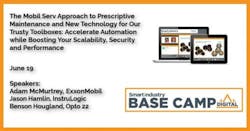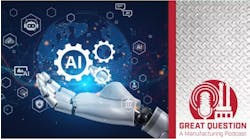During our last Smart Industry Base Camp Digital webinar, Adam McMurtrey will outline a human-centered, technology blueprint to build a best-in-class operation that provides the operational intelligence necessary to properly interpret actionable data and improve overall equipment efficiency and productivity.
Today the ExxonMobil field engineer previews his presentation, touching on predictive maintenance, capturing the “right” data, and the most underrated asset in Industry 4.0. Take a look…Smart Industry: How can manufacturing companies make the shift from reactive to predictive maintenance?
Adam: To build an effective predictive maintenance program, you need to have the right infrastructure and strategy in place to collect relevant data and then turn that data into actionable insights. This model is often called the “connected plant.”
Achieving this vision requires both technology and human capital, and the maturation of the Industrial Internet of Things, as well as sensor and telematics technologies, is providing operators with access to more data and insights than ever before. But, while the emergence of Industry 4.0 and the connected plant offers the promise of an exciting future, this vision will not be achieved through a plug-and-play model. To unlock the power of Industry 4.0, you need a human-led approach to building your technology stack and data strategies, one that incorporates an understanding of the needs and dependencies of your specific operation.
Many providers that offer IoT solutions, including OEMs, sensor companies and software vendors, discuss data opportunities through the narrow lens of their specific equipment. Further, many of these providers are not collaborating, so it can be difficult to connect disparate data streams and identify the most relevant data and insights to make decisions that improve performance. To make the most of each technology, there needs to be one strategy that connects them all.
This strategy should start with plant capacity and utilization—identifying operational goals and over-arching ambitions. Operators should then lean on in-house maintenance staff and external partners who have a keen understanding of process equipment and maintenance practices to identify which equipment performance metrics matter most toward achieving those goals and which portions of the operation are restricting and preventing the achievement of those goals the most (e.g. bottleneck and bottleneck-cost analysis). Then you can work with individual providers to identify the technology stack needed to bring that vision, as well as your predictive maintenance program, to life.
Smart Industry: Can you expand a bit more on the importance of capturing the right data?
Adam: With all of the various Industry 4.0 technologies on the market, some operators tend to gather an overabundance of data, making it hard to identify the most relevant information and insights to make decisions that improve performance.
As mentioned, understanding what data matters in helping you improve performance must start with identifying operational goals and working with knowledgeable team members to identify which parts of the operation most directly influence those goals. You then need go one level deeper and understand what data gives you the best insight into how that part of the operation is performing.
Let’s use a lubrication-specific example to bring this to life. If one of your goals is to reduce operational downtime, a key performance metric will be the reliability of critical equipment such as gearboxes. One of the most common data points used to monitor gearbox performance is vibration analysis, often measured with vibration sensors. But, while vibration analysis will help you understand if a gearbox is about to fail, it is in some ways a lagging indicator. A better predictor of equipment reliability is particle count, a less commonly monitored data point. If the particle count for key contaminants is high, that indicates that the gearbox is likely at risk and you can take action far sooner than you would if you only monitor vibration.
Through this more sophisticated approach, you can start to build a more effective predictive maintenance program.
Smart Industry: What is the human role in this digitalization process?
Adam: People are the most underrated asset in the deployment of Industry 4.0, and our internal research shows that few companies are properly measuring the impacts that their people have on their business and how that helps or hinders their Industry 4.0 progress. For example:
- How many of the employees at a given operation know how much their daily work contributes to the bottom line?
- Can they quantify the impact each of their work tasks has on the company—both when completed and, especially, when left incomplete?
- How effectively do maintenance, production, and procurement, and HR teams collaborate?
- How much do operators need to retain from an individual who is retiring or parting ways in pursuit of other opportunities?
- How much is actually retained?
When building out a predictive-maintenance strategy, companies should be considering all of these questions and working to ensure that they try to incorporate these considerations into their measurements. For example, performance metrics should be designed to incorporate the address the needs of multiple departments so that colleagues can efficiently measure the ROI of predictive maintenance programs.
If you are able to effectively connect these issues to your Industry 4.0 strategy, you will be able to unlock significant value that can help enhance the productivity and profitability of your operation.
Smart Industry: What excites you most about Industry 4.0?
Adam: I’m most excited to see industrial operators achieve their future-state visions. Many of our customers, for example, are in highly competitive industries and are focused on keeping business moving while also trying to manage new technologies. They’re juggling a lot. The current business environment only amplifies those challenges.
Industry 4.0, when integrated properly into a robust predictive maintenance program, provides operators with the opportunity to get ahead of operational goals and grow their business. As somebody who works with customers day in and day out to make improvements that help them achieve their operational goals, I’m excited to see how the industry works together to find new solutions that help accelerate that journey.




